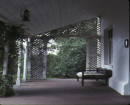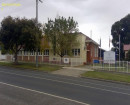THANES HOTEL SITE, KALKALLO
1210 HUME HIGHWAY KALKALLO, HUME CITY
-
Add to tour
You must log in to do that.
-
Share
-
Shortlist place
You must log in to do that.
- Download report
Statement of Significance
Data has been updated as a result of the Outer Western Metro Project, Context, March 2010.
-
-
THANES HOTEL SITE, KALKALLO - History
The Donnybrook Village Reserve was set aside in the original 1838 survey and its street pattern was determined by about 1850. The settlement (originally known as 'Rocky Water Holes') was a hive of activity by 1849, with the Argus of 12 December that year recording 'a fine store . two first rate inns, a post office, a watch-house etc.' and that passing traffic was 'very great. no less than 98 drays loaded with wool touched at this place last week'.
Between 1840 and 1860 the settlement was an important overnight stop for bullock-drivers and travellers to the north-east. The village was surveyed in 1852 and re-named Donnybrook when the post office was transferred here from Kinlochewe in 1853. It especially flourished during the 1850s because of travellers to the gold fields, at which time it had a police station, gaol and courthouse, a church, a school, a tannery and a flour mill. A cemetery was established in the locality around 1860, and by the mid 1870s most of the land in the area was well established as agricultural and pastoral freehold and village settlements had sprung up both at the railway line at the current Donnybrook and on the main north-south roads. To reflect this seperation, the latter was renamed Kalkallo in 1874 by government proclamation.
William Thane purchased the whole of Section 7 in the village in 1855 and erected a substantial two storey hotel on Lot 1 facing Sydney Road, which was operating by at least 1860 . William Thane was also the poundkeeper for Kalkallo (Payne 1974). 'Thanes Hotel' was offerred for sale in January 1864, at which time the notice of the sale described it as a 'Bluestone hotel of 12 rooms, stone stables, large water tank with 4 acres of productive garden and meadow land now occupied by Mr Thane. William Winter Treacy and Colin Stewart were subsequent owners before William Gadd who appears to have closed the hotel or converted it into a store in 1874 (Payne 1980).
(Partly derived from Maloney & Johnson 1998)
THANES HOTEL SITE, KALKALLO - Interpretation of Site
The site comprises a row of large mature pine trees along the site's Hume Highway frontage amongst which are scattered bluestone blocks (hand pressed bricks were also recorded here by the previous 2006 survey). These lie at the western edge of a rectalinear depression which probably represents the site of the hotel building.
North of the depression is a mature olive tree, a probable relic of the gardens recorded in the 1864 sales notice. Maloney and Johnston (1998) note that remnants of the garden and stables are recorded as extending north of the site, across the unused western part of the Arrow Smith Street road reservation and to the site of St Barnabas Anglican Church (H7822-0886).
Approximately 25 metres to the north east is a square bluestone lined depressed feature, the interior of which the previous survey records as being surfaced with cobbles but which was overgrown at the time of the recent survey. This may be an animal trough, or possibly the remains of a cistern. A row of bluestone wall footings were observed to the west of this feature.
THANES HOTEL SITE, KALKALLO - Archaeological Significance
The site has moderate potential to contain archaeological deposits that would demonstrate the history of thehotel and the Donnybrook (later Kalkallo) township.
THANES HOTEL SITE, KALKALLO - Historical Significance
The site has historical significance for its role in the development of the settlement of Donnybrook (later Kalkallo) and a mid 19th century hotel.
Heritage Inventory Description
THANES HOTEL SITE, KALKALLO - Heritage Inventory Description
Scattered bluestone blocks concealed within a row of pine trees along the Hume Highway, sitting in the western edge of a rectangular depression. Also a square bluestone lined trough and a line of bluestone footings. A mature olive tree stands to the north of the rectangular depression.
-
-
-
-
-
ST BARNABAS ANGLICAN CHURCH RUIN
 Victorian Heritage Inventory
Victorian Heritage Inventory -
KALKALLO POLICE PADDOCK SITE
 Victorian Heritage Inventory
Victorian Heritage Inventory -
Bluestone Bridge
 National Trust
National Trust
-
-







